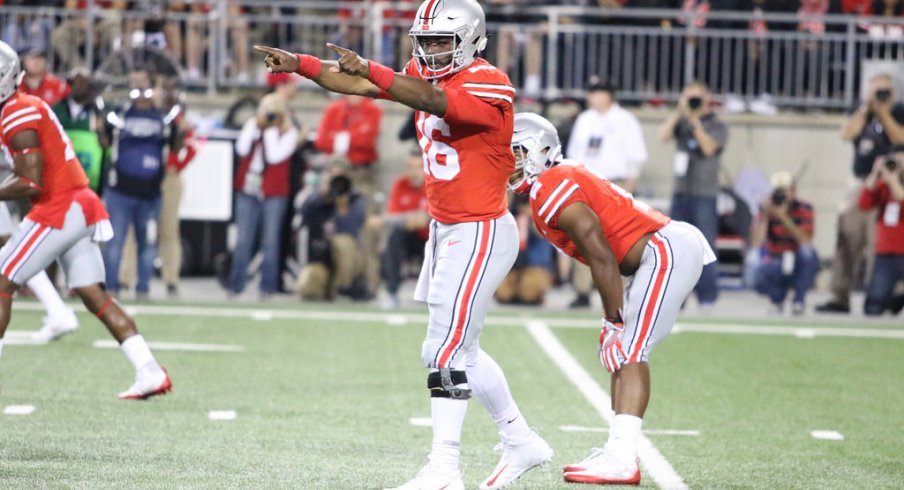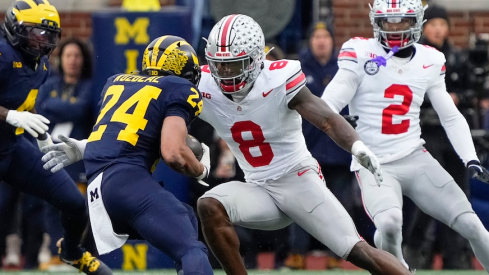"We've got to get the damn thing fixed, and we will." - Urban Meyer following Saturday's 31-16 loss to Oklahoma.
It certainly feels like we've seen this show before, doesn't it? Against a top opponent, the Buckeyes struggle to move the ball effectively, desperately chucking the ball downfield late in the hopes of mounting a comeback. Whether the loss came against Penn State, Clemson, or Oklahoma, the Ohio State offense has largely looked the same in all three contests, with some symptoms also showing up in wins going as far back as 2015.
Understandably, the blame has shifted over that time as well. First, it was the quarterback coach. Then, the play-calling, and the pass protection after that. Now, many want to blame the quarterback.
But as we've dissected many, many, many times before in this space, the issues with Meyer's offense are more complicated. Replacing a coordinator or a fifth-year senior may feel like a cure-all while the sting of a loss is still fresh, but the problems we've seen come to light time and time again involve more than just one person.
Yes, the quarterback missed some throws downfield. Yes, the receivers have struggled to gain separation and when they have, they've dropped passes (especially in the end zone). Yes, the pass protection on the right side hasn't been rock solid over the past two seasons. But these struggles are related.
Right now the Buckeye offense looks largely the same as it did when Meyer arrived in Columbus five seasons ago - to the point that the unit has lost nearly all ambiguity and any decent coaching staff worth their salt can identify the same concepts they'll see once lined up across from them. This may not matter against Army, UNLV, Rutgers, or Maryland, given the talent gap between those programs and the one in Columbus, but it certainly does when that divide shrinks.
Despite all the excitement about the hires of Kevin Wilson and Ryan Day, the game plan for week two looked nearly identical to that of week one, and Oklahoma was ready. But what Ohio State is suffering from right now isn't a crisis of concepts, but rather one of packaging.
Most offenses rely on the same core plays week to week, both on the ground and through the air. In fact, there really are only about eight to ten running plays and 15-20 passing concepts that every offense runs, all the way from the high school level to the NFL. What separates good offenses from the rest is certainly talent (something Ohio State has covered) and the way those concepts are disguised by formation, motion, or personnel.
If Meyer wants to get his offense fixed, the latter is a good place to start.
As we've discussed previously, combining run plays with 'relief' passing routes on the outside has been on the priority list for Wilson and Day, and so far, they've been working. Against Indiana, the Buckeyes combined a tight end 'arrow' route to the flat with a typical tight zone-read play, stressing both the play-side end and the slot defender.
In week two, we saw the same philosophy come to light in a new way:
Such packaged concepts fit Barrett's skill set perfectly, as he's always been one of the best 'readers' in America, allowing the defense's actions to dictate where the ball goes instead of deciding before the snap. These concepts leave Barrett with the option of handing the ball inside to a talented back, letting him use his own legs to pick up yards outside, or allowing him to throw a short pass to a receiver and let them attack open space.
The concept above was run at least a half-dozen times on Saturday night but was one of the only such packages of its kind seen from the Buckeyes that evening. Not only did it get the passing game going with nice pickups from K.J. Hill and Parris Campbell, it ignited the run game and was the very play called on J.K. Dobbins' third quarter touchdown.
But the run game seemed to disappear after that drive, as the Sooners responded with a touchdown of their own and took a two-possession lead. Yet, despite the fact that there was over a quarter left to play, Dobbins and the ground attack became largely forgotten from that point on.
"I wasn't happy with it," Meyer said about the running game. "So we'll just keep re-evaluating and I saw what you saw. J.K. was hitting the ball pretty hard and doing some good things. Mike Weber did some good things. And we're just not getting enough flow on offense. And I'm seeing the same things you guys are seeing."
One reason they may have gone away from running the ball was Oklahoma's odd front with a nose tackle directly over the center. Though that kind of look can plug up inside runs, the Buckeyes were prepared for it, flipping the roles in their typical zone-read and getting their talented backs out on the edge with a speed sweep option they call Bash.
Undoubtedly, the Buckeyes will lean heavily on their talented stable of backs in the coming weeks, looking to impose their will against lesser opponents. Plays like Bash, Power-Read, and Buck Sweep will all provide the needed balance to the inside ground game for which Meyer's offenses are known.
But that balance is what's been missing most from the Buckeye offense.
"When you block and execute it’s good, but again, our line has been outstanding, our quarterback has been outstanding," Wilson noted after the loss to the Sooners. "We have got to put it together and we didn’t and that is my fault. I own that."
If Wilson, Day, and Meyer want ideas for where to find that balance they crave, they don't have to look much farther than the film of their last two losses. While Baker Mayfield and Deshaun Watson deserve a ton of credit for their play-making abilities, both quarterbacks left the Buckeye defense on their heels thanks to the way their spread-to-run offenses packaged plays.
Although the Clemson offense may find more roots in the one-back offense, similar to Meyer's, the Sooner offense in years past had to find solutions to a problem the Buckeyes may now face themselves. Simaje Perine and Joe Mixon were undoubtedly Oklahoma's two most talented offensive weapons in 2015 and 2016, but since both played the same position, Lincoln Riley became quite creative with the way he ran from a 2-back shotgun set - so much so that he kept some of those play designs in the game plan even after both backs left for the NFL:
Both Dobbins and Weber are more than capable of making that catch from the backfield, as are 'H' receivers Campbell and Hill, although neither of whom has been spotted moving around the formation before the snap so far this season. In fact, only Terry McLaurin's second half 'Cowboy' motion behind the shotgun QB to set up a swing pass has been the only real pre-snap movement through two games.
This lack of movement allows the defense to settle in and diagnose tendencies with plenty of time while also hiding their coverage schemes from Barrett. Even short motions sending one receiver from the slot to the numbers or bringing the tight end across the formation just before the snap would give Barrett valuable clues to diagnose the defense's intentions.
But motions also don't just have to be a decoy. Though many fans tired of seeing jet sweeps over the past few seasons, there are plenty of creative ways to package that movement with an inside run, something Mayfield executed perfectly against the Buckeyes Saturday night:
As Mayfield and the Sooner receivers showed, easy throws like this not only open up the inside running game but also develop rhythm and confidence in the passing game. While Oklahoma's star QB completed 27 of 35 attempts against the Buckeyes, very few were traditional drop-back passes, and most came as quick-release RPOs or reliefs.
Conversely, in all three losses the Buckeyes have experienced over the past 12 months, they've looked to build that confidence by either taking deep drops and looking downfield or waiting for slow-developing crossing routes underneath to come open. That's not to say those concepts don't belong in the playbook (they certainly do), but for an entire unit playing without much confidence these days, those can be very difficult concepts to execute.
Luckily, the pressure is now off for the Buckeyes. As they know too well, a loss at home in week two doesn't mean their playoff hopes are dashed, and an easy string of opponents over the next six weeks allows them to build momentum before welcoming Penn State back to the Horseshoe in what will likely make or break the 2017 season for both teams.
"We got to go beat Army is what we got to do, and get on a roll," Meyer said immediately after the Oklahoma loss. "That's what we got to do. You've seen a roll around here a few times. So that's what has to happen."
We'll certainly be watching that roll closely, but so will opposing coaches, and a little imagination now might go a long way later in the season.



